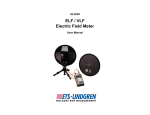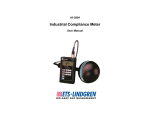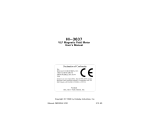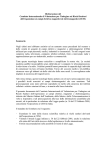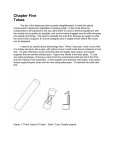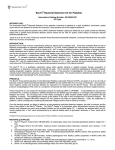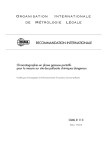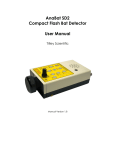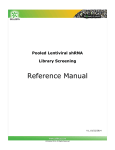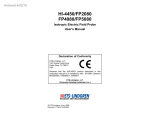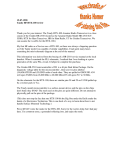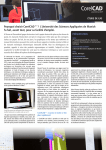Download HI-3603 VDT/VLF Survey Meter User`s Manual - ETS
Transcript
HI-3603 VDT/VLF Survey Meter User's Manual Declaration of Conformity ETS-Lindgren, L.P. 1301 Arrow Point Drive Cedar Park, TX 78613 USA Declares that the HOLADAY product described in this instruction manual is in compliance with: EN EMC Directive 86/336/EEC, EN50082-1, EN55011 ETS-Lindgren, L.P. (Formerly Holaday Industries, Inc.) © ETS-Lindgren, August, 2005 Revision E, Part # H-600042 HI-3603 VDT/VLF Survey Meter ETS-Lindgren L.P., reserves the right to make changes to any product described herein in order to improve function, design, or for any other reason. Nothing contained herein shall constitute ETS-Lindgren L.P. assuming any liability whatsoever arising out of the application or use of any product or circuit described herein. ETS-Lindgren L.P. does not convey any license under its patent rights or the rights of others. © Copyright 2005 by ETS-Lindgren L.P. All Rights Reserved. No part of this document may be copied by any means without written permission from ETS-Lindgren L.P. EMAIL & INTERNET ADDRESSES [email protected] http://www.ets-lindgren.com USA 1301 Arrow Point Dr., Cedar Park TX 78613 USA P.O. Box 80589, Austin, TX 78708-0589 USA Tel 512.531.6400 Fax 512.531.6500 FINLAND Mekaanikontie 1, 27510, Eura, Finland Tel 358.2.838.3300 Fax 358.2.865.1233 JAPAN 4-2-6, Kohinata Bunkyo-ku Tokyo 112-0006 JAPAN Phone + 81 3 3813 7100 Fax + 81 3 3813 8068 CHINA 1917-1918 Xue Zhixuan Building No 16 Xue Qing Road Haidian District Beijing Postcode: 100083 CHINA Phone + 86 010 82755304 Fax + 86 010 82755307 2 © ETS-Lindgren, August, 2005 Revision E, Part # H-600042 HI-3603 VDT/VLF Survey Meter REVISION RECORD HI-3603 VDT/VLG Survey Meter Revision A B C D E Description Initial Release New LCD Revised Spec Revised Spec Added CE Label Revised Addresses © ETS-Lindgren, August, 2005 Revision E, Part #H-600042 Date August, 1992 December, 1992 August, 1994 December, 1995 June, 1997 August, 2005 3 HI-3603 VDT/VLF Survey Meter This page intentionally left blank. 4 © ETS-Lindgren, August, 2005 Revision E, Part # H-600042 HI-3603 VDT/VLF Survey Meter Table of Contents 1.0 Introduction.............................................................. 7 2.0 Getting Started...................................................... 11 Specifications......................................................................... 11 3.0 Operation ............................................................... 17 Start Up.................................................................................. 17 Electric Field/Magnetic Field Mode Selection........................ 19 VDT Characteristics ............................................................... 24 Characterizing VDT Emissions and Operator Exposure ....... 30 Guidelines for RF Exposure................................................... 36 Specialized Measurements with the HI-3603 ........................ 38 4.0 Maintenance.......................................................... 43 Battery Replacement ............................................................. 43 5.0 Warranty Policy for Electromagnetic Isotropic Field Monitoring Components ...................................... 45 Scope and Duration of Warranties......................................... 45 Warranty Exclusions .............................................................. 46 Buyer’s Remedies.................................................................. 47 6.0 Appendix A: Using the HI-3616 Fiber Optic Remote Control............................................................... 49 Turn-on Procedure When Using the HI-3616 ........................ 49 Using the Recorder Output .................................................... 50 7.0 Appendix B: References .................................... 51 © ETS-Lindgren, August, 2005 Revision E, Part #H-600042 5 HI-3603 VDT/VLF Survey Meter This page intentionally left blank. 6 © ETS-Lindgren, August, 2005 Revision E, Part # H-600042 HI-3603 VDT/VLF Survey Meter 1.0 INTRODUCTION The HI-3603 VDT/VLF Radiation Measurement System is designed specifically to measure electromagnetic emissions produced by video display terminals (VDT's), computer monitors, television receivers and other devices using cathode-ray tubes (CRT's) for information or data display. While a number of scientific research studies have been completed, there is currently no definitive evidence of a hazard to VDT users that may come about from the electromagnetic field emissions at typically encountered levels. Despite the absence of a confirmed hazard impact with VDT use, there is an increasing interest in performing baseline surveys of employee exposure to VDT emissions in the automated office environment. The HI-3603 VDT/VLF Radiation Survey Meter has been designed to permit rapid and accurate measurement of the electric and magnetic fields generated by VDT's and is rapidly developing a reputation as the instrument of choice for such surveys. The HI-3603 VDT/VLF Radiation Survey Meter is but one of a family of measuring devices that covers a wide range of electromagnetic field measurement needs. The HI-3603 has two switch selectable sensors for measuring both electric and magnetic fields. The instrument’s capabilities include data logging, waveform output, full auto-ranging, and a custom Liquid Crystal Display (LCD) with a bar graph, as standard features. All selection and control functions are input from a front panel membrane switch. True RMS detection assures accurate measurements of complex waveforms. The waveform output jack allows observation and evaluation of the actual waveform being measured. The data logger feature captures up to 112 field readings for later review using front panel controls. Microprocessor technology is incorporated in the HI-3603 to provide for automatic range changing (manual range changing may be selected) and automatic zeroing of the instrument. The unique nature of the VDT as an RF radiation source demands that rather innovative approaches be taken to accurately assess the magnitude of the emissions (see the section marked VDT Characteristics for more explanation of the characteristics of VDT's). Building on the pioneering © ETS-Lindgren, August, 2005 Revision E, Part #H-600042 7 HI-3603 VDT/VLF Survey Meter contributions of S. M. Harvey at the Research Division of Ontario Hydro (Canada) (Harvey, 1982; 1983a; 1983b; 1984a; 1984b; 1985), the HI-3603 VDT/VLF Radiation Measurement System incorporates technology described in a report developed by A. W. Guy, Director of the Bio-electromagnetics Research Laboratory, Center for Bioengineering, at the University of Washington for the National Institutes for Occupational Safety and Health (NIOSH). This report (Guy, 1987), describes the basic concepts upon which the Holaday HI-3603 was developed. The HI-3603 is a single axis (responsive to one polarization component at a time) field-strength meter designed to be responsive to the complex (non- sinusoidal) electromagnetic fields generated by VDT's over a broad frequency range. It directly displays the root-mean-square (RMS) value of the electric and magnetic field strengths on a LCD screen. Figure 1 illustrates the HI-3603 with its paddle-like sensor. Figure 1:The HI-3603 VDT/VLF Radiation Survey Meter 8 © ETS-Lindgren, August, 2005 Revision E, Part # H-600042 HI-3603 VDT/VLF Survey Meter Electric fields are measured through the employment of a displacement current sensor. A displacement current sensor operates on the principle that two parallel conductive flat-plate electrodes, when electrically connected together, will exhibit a displacement current that flows between the two plates when immersed in an electric field. This can be visualized by remembering that the electric field between two such plates must be zero when they are connected together; i.e., because they are at the same potential there can be no electric field between them (an electric field exists when the potential on the two electrodes is different). Another way of viewing this phenomenon is to understand that when immersed in an electric field, the external field causes a redistribution of electric charge on the two electrodes and this redistribution of charge is in reality just a flow of current, a displacement current, between the two plates. The HI-3603 uses this principle to detect electric fields by measuring the displacement current caused by the ambient field between two closely spaced circular disks. By placing such a detector in a known electric field, the displacement current can be related directly to the magnitude of the field causing it, permitting its calibration. A circular sensing plate surrounded by a "guard ring" is used in the HI-3603 and the displacement current developed between this smaller diameter disk and a closely spaced eight inch circular disk electrode is sensed and converted to equivalent electric field strength. Because the larger electrode is used as a reference in the measurement process, for accurate measurements of electric fields, the sensor must be oriented in such a way that incident field lines strike the smaller disk. To aid the user in this, the sensing paddle probe is clearly illustrated, showing the normal orientation for measurement of both electric and magnetic fields emerging from VDT's. Magnetic fields are measured through the use of a three-turn loop wound about the periphery of the circular electric field sensing electrodes. This loop is shielded from electrostatic fields, insuring that its response is due solely to the magnetic field. Open circuited loops are frequency sensitive devices that provide an output that is proportional to the time rate of change of the magnetic field fluxing through the aperture of the loop. In contrast to this, in the case of the HI-3603 design, the loop © ETS-Lindgren, August, 2005 Revision E, Part #H-600042 9 HI-3603 VDT/VLF Survey Meter sensor has been resistively loaded to produce a relatively flat response over the frequency range of interest for VDT emissions and an output that is proportional to the magnitude of the magnetic field. Thus, the HI-3603 is capable of accurately measuring the strength of magnetic fields from all kinds of VDT's, regardless of their frequency of operation. VDT's, because of their circuitry, produce several kinds of electromagnetic emissions. These include 60 Hz AC fields associated with the power supply, ELF (Extremely Low Frequency) fields produced by the vertical deflection of the electron beam, DC fields produced by the high DC voltages applied to the CRT to accelerate the electron beam toward the CRT screen (this DC field possesses a 60 Hz modulation), and RF fields caused mainly by the flyback circuitry (that circuitry associated with the horizontal deflection of the electron beam and its return to one side of the screen-the flyback). The HI-3603 is designed to be responsive to these RF emissions of VDT's. It has been designed to minimize response to other emissions. NOTE: When using the ¼-20 UNC mounting holes, the maximum length of screw thread is 10 mm (0.4 inches). If longer threads are used they may extend into the instrument case and cause damage to the internal circuit board. 10 © ETS-Lindgren, August, 2005 Revision E, Part # H-600042 HI-3603 VDT/VLF Survey Meter 2.0 GETTING STARTED SPECIFICATIONS • Concentric plate displacement current electric field sensor. • 8 inch diameter magnetic field sensing loop • Switch selectable between electric and magnetic fields Sensitivity: • Electric fields - 1 - 1999 V/m • Magnetic fields - 1 - 1999 mA/m Features: • All function and range selection changes are made by use of the membrane switch keypads on the front panel. • Internal electronic range switching allows full auto-ranging on either the Electric or Magnetic field functions. • Max-hold feature stores and displays highest reading Response: True RMS field measurement for accurate measurement of non-sinusoidal waveforms Frequency Electric fields: Response: • ±0.5 dB, 10 kHz to 100 kHz • +0.5/-2 dB, 2 kHz to 300 kHz Magnetic fields: • ±0.5 dB, 12 kHz to 200 kHz • +0.5/-2dB, 8 kHz to 300 kHz Determined with applied electrical field strength of 143 V/m and an applied magnetic field strength of 166 mA/m in auto-range mode. Temperature 20°F - 105°F Range: (-10°C - 40°C) Power: Two (2) nine-volt alkaline batteries (NEDA 1604A, Duracell MN1604, or equal) Output: Liquid crystal display, preamplifier output via phono jack (analog signal from sensor/preamplifier equal to 1 mV/(mA/m), digital fiber optic signal (for remote reading via connection to HI-3616 Fiber Optic Remote Control) Sensors: © ETS-Lindgren, August, 2005 Revision E, Part #H-600042 11 HI-3603 VDT/VLF Survey Meter The HI-3603 VDT/VLF Radiation Survey Meter package includes the Readout-Sensor Assembly, batteries, fitted carrying case, and a user manual. Instrument accuracy is derived from a field calibration using a one meter diameter pair of Helmholtz coils for establishing an accurately known magnetic field strength and a transverse electromagnetic (TEM) cell for creating a known electric field strength. In the case of the Helmholtz coils, a precisely controlled and measured sinusoidal current is driven through the coils and, based on the dimensions of the coils, the magnetic field strength in milliamperes per meter (mA/m) is calculated (Tell, 1983). For electric fields, a sinusoidal voltage impressed across the cell, is directly measured and, using the spacing between the TEM cell's septum and wall, the electric field strength in volts per meter (V/m) is determined as the voltage difference divided by the spacing (Mantiply, 1984). In each case, both currents and voltages in the calibration set-ups are determined with a true RMS detector. The HI-3603 indicates magnetic field strength in units of either milliamperes per meter (mA/m), gauss (G), or tesla (T). Magnetic field strength may be converted to the different units through the following relations: 1 mG = 1,000 µG = 80 mA/m 1 mT = 1,000 µT = 800,000 mA/m 12 © ETS-Lindgren, August, 2005 Revision E, Part # H-600042 HI-3603 VDT/VLF Survey Meter Figure 2: Typical Frequency Response Figure 2 demonstrates a typical frequency response plot for both electric and magnetic fields for the HI-3603. Note that the bandpass of the HI-3603 is designed to limit response to fields generated by 60 Hz sources and other emissions below approximately 5 kHz. In a similar fashion, high frequency response is controlled to minimize detection of fields above approximately 300 kHz. The frequency response data plotted in Figure 2 were obtained with applied field strengths of 143 V/m and 166 mA/m for electrical and magnetic fields respectively with the HI-3603 in its auto-range measurement mode. The bandwidth of the true RMS detector is a function of the amplitude of the applied field. The bandwidth of the HI-3603 is also related to the particular measurement range selected. Thus, for a specific measurement, the bandwidth exhibited may be greater or lessor than shown in Figure 2. Generally maximum bandwidth, and thus accuracy, is obtained for any given field strength by selecting the lowest range that still permits an on-scale reading. Using the auto-range © ETS-Lindgren, August, 2005 Revision E, Part #H-600042 13 HI-3603 VDT/VLF Survey Meter mode of the HI-3603, the frequency response for the principal VDT fly-back circuit emissions will be flat within ± 1 db or better. Subjecting the instrument to electric or magnetic fields with different waveforms but having the same RMS magnitude can assess the effectiveness of the true RMS detector in the HI3603. Representative data from such a test are given below where the instrument response to a sinusoidal waveform is compared to its response to a saw-tooth waveform similar to that found in VDT's (a rise time equal to 9 times the duration of the fall time of the signal) but having the same RMS magnitude. Frequency Sine wave Saw-tooth Difference wave 10 kHz 253 264 4.3% 20 kHz 297 296 0.3% 50 kHz 300 298 0.7% Table 1: Relative HI-3603 Reading (mA/m) As can be seen, the HI-3603 responds to the non-sinusoidal waveform fields within 4 percent of the sinusoidal waveform, showing that it can be used with confidence in VDT-like waveform fields. The HI-3603 also provides for monitoring the waveform of the signal coming from the sensor preamplifier circuit in the input module. This signal is available from the phono jack located at the bottom of the instrument. Connection of an oscilloscope to this jack will allow observation of the preamplifier output. Figures 3 and 4 illustrate the HI-3603's response to 30 kHz saw-tooth waveforms for both electric and magnetic fields respectively. The rise time of this waveform was 9 times the fall time. In each oscilloscope display, both the applied waveform and the sampled waveform are shown simultaneously. It can be seen that the reproduction of the electric field waveform is very clean and virtually identical to the applied field. In the case of magnetic fields, the broadbanding circuitry associated with the loop sensor leads to some distortion in the monitored waveform, principally in the relatively slowly rising part of the saw-tooth. This comes about partially because of the tailored frequency response that attenuates response to signals below about 10 kHz. The fidelity 14 © ETS-Lindgren, August, 2005 Revision E, Part # H-600042 HI-3603 VDT/VLF Survey Meter to more rapidly changing fields, however, similar to that which occurs during the VDT flyback period, is quite accurate and suffers less distortion. Use of this output signal for specialized measurements of VDT's is covered in Appendix A. Figure 3: Electric field response of HI-3603 to a 30 kHz sawtooth waveform with a 9:1 symmetry ratio as observed at the preamplifier output jack. The display shows both the applied field waveform and the preamplifier output waveform superimposed; the waveforms cannot be distinguished. © ETS-Lindgren, August, 2005 Revision E, Part #H-600042 15 HI-3603 VDT/VLF Survey Meter Figure 4: Magnetic field response of HI-3603 to a 30 kHz saw-tooth waveform with a 9:1 symmetry ratio as observed at the preamplifier out jack. The display shows both the applied field waveform and the preamplifier output waveform superimposed; distortion of the slow part of the saw-tooth ramp is apparent but the rapid flyback transition shows no distortion. 16 © ETS-Lindgren, August, 2005 Revision E, Part # H-600042 HI-3603 VDT/VLF Survey Meter 3.0 OPERATION NOTE: The HI-3603 is enclosed in a rugged aluminum extruded case for protection of its internal circuitry. Because of the nature of its intended use, the field sensor extends from the readout module. The structure of the sensor is a multilayered printed circuit board. It is well secured internally to the aluminum case and has a tough polyester covering but is exposed to greater potential for physical damage because of its size and location. Use care in handling the HI-3603 to avoid damaging the sensor by striking it against objects or applying excessive force to the sensor paddle. When not in use, keep the HI-3603 in its protective case where the sensor paddle is properly supported. START UP Membrane switches are used for controlling the HI-3603's operation. The switch keypads are activated by gently pressing on the center of the pad with a finger tip. Do not use hard or pointed objects to operate the switch keypads. Turn the unit ON, the default measurement condition is Magnetic Fields. The custom LCD readout displays the units of measure in addition to the observed value. A Bargraph display is provided along the top of the LCD window. This display is an analog approximation of the currently displayed digital value as a percentage of the full-scale range. The BarGraph input is unfiltered for fast response when searching for peak fields. © ETS-Lindgren, August, 2005 Revision E, Part #H-600042 17 HI-3603 VDT/VLF Survey Meter The digital display response is digitally filtered for increased ease of operation. This smooths the response to rapidly changing fields. In some measurement situations, however, it may be helpful to increase the response of the digital display, ie. reduce the response time. This is done when the instrument is turned on. Refer to KEYPAD MATRIX in this section, and the operation of the E/H keypad for details. Figure 5: HI-3603 VDT/VLF Survey Meter The default display response filter is F-2 (refer to KEYPAD MATRIX in this section for more information). The instrument will normally be received from the factory with this setting (F-2). The display response setting is stored in the non-volatile memory of the HI-3603 and if the setting is changed, the new setting will be saved and will become the default condition. For this reason, we recommend that you check the display response setting when you first receive the instrument and after battery replacement. The display response setting does not affect the accuracy of the instrument. The battery condition is indicated by a small "battery" symbol in the lower left corner of the LCD. As the battery voltage decreases, the low battery symbol begins to blink. If the battery 18 © ETS-Lindgren, August, 2005 Revision E, Part # H-600042 HI-3603 VDT/VLF Survey Meter condition is allowed to drop below that necessary for proper operation, the display will go blank. DIGITAL DISPLAY The HI-3603 uses a custom Liquid Crystal Display to provide information on instrument setting as well as the variables being measured. Refer to Figure 6 for the display outline. Figure 6: Display Outline ELECTRIC FIELD/MAGNETIC FIELD MODE SELECTION The HI-3603 measures both electric (E) and magnetic (H) fields. The unit is switched between the E and H field modes using the membrane switch panel keypads. KEYPAD INPUTS ON/OFF - Pressing the ON/OFF keypad turns the instrument on; pressing the ON/OFF keypad again turns the meter off. As there is no automatic turn off on the HI-3603, turn the instrument off when not in use or between readings. No warm up is required before using the instrument. © ETS-Lindgren, August, 2005 Revision E, Part #H-600042 19 HI-3603 VDT/VLF Survey Meter KEYPAD MATRIX For maximum flexibility in operation, the HI-3603 has a keyboard matrix for the upper three keypads on the membrane switch panel. The function of each of the three keys can be changed depending on the location of the CURSOR block in the LCD display. The cursor block is a dark rectangle located at the bottom edge of the LCD display. On turn on, the cursor is located above the leftmost of the three columns of functions on the control panel. In this mode the functions of the three topmost keys are as follows: A. SCALE B. MAX C. E/H MODE SELECT - Pressing the MODE keypad moves the cursor to the right; each push of the pad moves the cursor one position. From the third, or rightmost, position, the cursor moves around to the first position. This allows a total of nine (9) different functions to be assigned to the three keypads. The MODE SELECT keypad is also used to change the display response filters as well as the magnetic field units of measure. When the meter is turned on, a self-test procedure is automatically performed. As part of this procedure, all segments of the display are lit for about two seconds. To review or change the filter and unit settings, press and hold the MODE SELECT keypad while all the segments are lit. In this mode two settings can be changed. Pressing the E/H keypad will step through the filter settings. Pressing the MAX keypad will step through the Hfield units of measure. Refer to the descriptions of the E/H and MAX keypads for further details. When the settings are adjusted to the desired values, again press the MODE SELECT keypad to leave the setup mode and begin normal measurement operation. The operational description of the various functions is as follows: 20 © ETS-Lindgren, August, 2005 Revision E, Part # H-600042 HI-3603 VDT/VLF Survey Meter SCALE - The SCALE keypad changes the fixed ranges or scales of the instrument. When turned on, the HI-3603 is in the AUTO RANGE mode. The unit determines the correct range within the current mode (E or H field) according to the detected field level. As the field being measured increases or decreases, the range is automatically selected for best resolution and accuracy. In some situations, it may be helpful to fix the scale of the instrument. Pressing the SCALE keypad once fixes the instrument on the current scale setting. Each successive operation of the keypad moves the scale to the next least sensitive range. When the least sensitive scale has been selected, the next operation of the keypad will shift to the most sensitive range again. To return to the AUTO RANGE mode, press and hold the SCALE keypad until the AUTO indication is shown in the upper left area of the LCD. MAX - While using the instrument for field measurements, the processor is continually saving the highest indicated reading. To recall and display the highest reading, press the MAX keypad. This maximum reading is indicated as long as the MAX keypad is activated. The maximum reading is indicated by the MAX indication near the right edge of the LCD. On releasing the MAX keypad, the reading is held for about two seconds and then the memory is cleared and a new maximum reading accumulated. When the instrument is shifted between the electric and the magnetic field mode, the MAX reading memory is cleared. The MAX keypad is also used to adjust the H-field units of measure. This is done just after the meter is turned on. During the self-test routine, the display will show all segments lit. When all the segments are lit, press and hold the MODE SELECT keypad to enter the display setup mode. Hold the MODE SELECT keypad until the display reads "F-#" and the current Hfield unit of measure. Press the MAX keypad to scroll through the available units. Once the desired units are selected, press the MODE SELECT keypad to save the current setup, leave the setup mode, and begin normal measurement operation. © ETS-Lindgren, August, 2005 Revision E, Part #H-600042 21 HI-3603 VDT/VLF Survey Meter E/H - Pressing the E/H keypad toggles the operation mode between Electric and Magnetic field indications. The current measurement units are displayed to the right of the reading on the LCD. The E/H keypad is also used to adjust the display response time. This is done just after the meter is turned on. During the self-test routine, the display will show all segments lit. When all the segments are lit, press and hold the MODE SELECT keypad to enter the setup mode. Hold the MODE SELECT keypad until the display reads "F-#" and the current H-field unit of measure. Press the E/H keypad to scroll through the four display filter settings. F-4 has the "fastest" response time, ie. the least filtering. F-1 has the "slowest" response time, ie. the most filtering. The difference in response from level to level is a factor of 2. Experiment with the settings to find which response level is best suited to your measurement requirements. Once the desired units are selected, press the MODE SELECT keypad to save the current setup, leave the setup mode, and begin normal measurement operation. The instrument will normally be received from the factory with the display response filter set at F-2. The display response setting is stored in the non-volatile memory of the HI-3603 and if the setting is changed, the new setting will be saved and will become the default condition. We recommend that you check the display response setting when you first receive the instrument and after battery replacement. The display response setting does not affect the accuracy of the instrument. BATT - The BATT keypad displays the supply battery voltage along with the battery symbol. The low battery indication will begin to flash at about 7.5 volts. When the battery voltage drops to 7.25 volts, the display will blank with only the BATT symbol displayed and the batteries must be replaced. 22 © ETS-Lindgren, August, 2005 Revision E, Part # H-600042 HI-3603 VDT/VLF Survey Meter DISP 3/4 - Pressing the DISP pad will shift the display from 4 to 3 digits and back again. In some situations where the measured field is fluctuating, the three digit display will make reading the instrument easier. CLEAR DATA - Clears values stored in the data logging memory. Pressing this keypad will clear all data stored in the data logging memory. When the keypad is pressed a flashing clr is indicated. Holding the keypad until 000 is shown will clear the memory. LOG - Pressing the LOG pad will store the current reading in the data logging memory. When the LOG pad is pressed, the identification number of the value (1-112) is displayed for about one second followed by the stored value. Immediately upon releasing the key, a new value may be logged by again pressing the LOG pad. Up to 112 values can be stored in this memory. When the memory is filled, successive operations of the LOG key will store the most current reading in memory location 112. PREV - Pressing the PREV key displays the last stored data value. When the key is pressed, the identification number of the value is first displayed for about one second followed by the stored value. The stored value is displayed as long as the key is depressed. About two seconds after releasing the key, the display returns to the current reading. Successive operations of the key will move the displayed value down towards the beginning of the memory (value identification #1). If the PREV key is operated while viewing value #1, the identification value will "wrap around" to the highest stored identification number. NEXT - Pressing the NEXT key displays the next value in the data logging memory. If the NEXT key is operated while viewing the last stored value, the identification number will "wrap around" to value number one. © ETS-Lindgren, August, 2005 Revision E, Part #H-600042 23 HI-3603 VDT/VLF Survey Meter When the displayed value is below 5% of the current full scale, the arrow at the left end of the BarGraph display will indicate. When the "Below Range" arrow is indicating, the accuracy of the reading may not be within the specified tolerance. When possible, the scale should be changed to permit a normal field strength reading without the "Below Range" indication. If the displayed value is too high, the " Over Range" arrow at the right end of the BarGraph, will indicate. Select the next appropriate scale. VDT CHARACTERISTICS Video display terminals (VDT's) and television receivers are quite similar in certain respects. Both are used to display information; the VDT displaying information received from a computer system, word processing system, or other digital information system and the television receiver displaying video information transmitted from television broadcast stations. In conjunction with a keyboard, the VDT serves as the main interface between the operator and a word processor, computer, etc. Television receivers are sometimes used in lieu of VDT's with home computer systems. PRINCIPLE OF OPERATION VDT's and television receivers use the same basic principles of operation. Both contain a large evacuated glass tube called a cathode-ray tube (CRT), or picture tube in the case of television receivers. The CRT contains a source of electrons (the cathode) at one end and a fluorescent coating on the inside of the viewing screen. Electrons released from the cathode are accelerated by a high voltage (typically in the range of 10 to 25 kilovolts) and are projected onto the fluorescent material of the screen which then emits visible light when it is struck by the fast-moving electrons. The CRT also includes various electrodes for focusing the electron beam and for scanning the beam across the fluorescent screen. Electronic circuitry in the VDT modulates the electron beam to produce the intended images on the screen. This circuitry leads to the production of electromagnetic fields (emissions). There are four basic aspects to the electrical environment of VDT emissions: (1) 60/50 Hz modulated DC fields; (2) 60/50 Hz fields; (3) RF fields associated with the 24 © ETS-Lindgren, August, 2005 Revision E, Part # H-600042 HI-3603 VDT/VLF Survey Meter horizontal and vertical deflection systems; (4) broadband RF fields caused by the digital electronic circuits which are associated with character generation (Roy, et. al, 1983). MODULATED DC FIELDS To accelerate the electron beam toward the screen, a high DC voltage is used. The high voltage is produced by pulsing a transformer which has a high turns ratio and is often derived from the deflection circuitry, though in some cases it may have a higher frequency depending on the character display system. The drive pulse is a square wave which produces a high voltage secondary pulse that is rich in harmonic content. The AC components of this DC current pulse flow to ground via the capacitance formed by the CRT screen and the resistive coating on the outside of the CRT. This small capacitance provokes the filtering necessary for a smooth high voltage accelerating potential. Roy et. al (1983) have reported that one method of reducing the AC component of the DC field is to place an RC filter network between the high voltage transformer output and the CRT. They found that such a filter could, in some VDT's, reduce the AC component of the DC field by as much as 50 dB (a factor of over 300 times). The modulated DC field is produced by the charge on the face of the CRT and is largely confined to the front of the unit. This field is highly variable, being affected by humidity, capacitance between the CRT and external objects and touching the CRT (Harvey, 1984a). Several investigators have measured the strength of this DC field and found values ranging from a few hundred volts per meter to as high as 45 kV/m at the surface of the body of an operator, and depending on the proximity of the operator to the VDT, closer distances resulting in higher measured incident DC fields (Olsen, 1981;Harvey, 1984b;Nylen et al., 1984;Bracken et al.,1985). © ETS-Lindgren, August, 2005 Revision E, Part #H-600042 25 HI-3603 VDT/VLF Survey Meter 60/50 HZ FIELDS These fields are caused primarily by the current flowing in the vertical deflection coil and are nearly symmetrical around the coil. It is produced by the same mechanism that produces the DC field; the charge on the VDT screen that produces the DC field is actually not constant but builds up and decays by a small amount each time the display is scanned by the electron beam. This occurs at a nominal 60 Hz rate although harmonics may exist up to several kHz (Harvey, 1983a). Measurements of the 60 Hz emissions and harmonics by Stuchly et al. (1983) found magnetic field strengths of 100 to 200 mA/m at a position 30 cm in front of the VDT. Harvey (1984b) reported measured 60 Hz AC electric field strengths of between 5 and 60 V/m in an investigation of 5 VDT's. These relatively low values are in the range of other commonly encountered 60 Hz appliances found in the home and office environment. DEFLECTION SYSTEM FIELDS The principal RF component of VDT emissions is caused by the so-called flyback transformer circuitry which is responsible for a rapidly changing current which flows in the horizontal deflection coils of the VDT and causes the electron beam to be rapidly swept to the left side of the screen, ready for another trace across the screen. The rate at which the electron beam is scanned is dependent on the particular design of the VDT but typically falls in the range of 17 to 30 kHz. For television receivers, the flyback frequency is approximately 15.75 kHz. The flyback circuit is rich in harmonic production and any instrument intended for accurate assessment of RF exposure fields produced by VDT's must be capable of true RMS measurement. The strong harmonic content of the flyback signal means that it has a non-sinusoidal waveform; the HI-3603 incorporates a true RMS detector circuit that can accurately respond to the complex waveforms observed near VDT's. Approximately 95 percent of the total energy of the flyback circuit emissions is contained within the first five or six harmonics. Consequently, the bandpass of the HI-3603 has been tailored to the necessary frequency range to capture all the important 26 © ETS-Lindgren, August, 2005 Revision E, Part # H-600042 HI-3603 VDT/VLF Survey Meter harmonics. See Figure 2 for an illustration of the frequency response of the HI-3603. In addition to the horizontal sweep-frequency circuit, there is a vertical deflection circuit that is used to deflect the electron beam down the CRT screen and in so doing produce characters. The vertical sweep frequency is approximately 60 Hz. The horizontal deflection circuit operates on the principle that the force exerted on a moving electron is at right angles to both the direction of the electron's motion and the applied magnetic field. To induce a horizontal component to the electron's original direction, the magnetic field must possess a vertical polarization. Thus, the horizontal deflection coils in VDT's and television receivers tend to generate magnetic fields that are strongly vertically polarized near the front of the screen. This aspect is important when characterizing the magnetic fields of VDT's with the HI-3603 (see the Characterizing VDT Emissions and Operator Exposure section). RF fields caused by the deflection circuitry can produce electric fields at normal operator positions of typically a few V/m up to some tens of V/m and magnetic fields in the range of a few mA/m up to several hundred mA/m (Harvey, 1983b; Guy, 1987; Boivin, 1986; Joyner et al., 1984; Marha and Charron, 1983). The HI-3603 is designed specifically for measurement of the RF fields associated with the beam deflection systems in VDT's and television receivers. BROADBAND RF FIELDS An electronic clock within the VDT, which typically operates in the frequency range of 1 to 20 MHz, is the source of most of the radiated RF signals from the digital electronics sub-section (Roy et al., 1983). Conventional shielding techniques are the usual method for eliminating or reducing such emissions. Petersen et al. (1980) and Weiss and Petersen (1979) evaluated RF emissions from a number of VDT's and found that RF electric field strengths, measured at a distance of 1.5 meters from the front of the VDT, for those emissions not associated with the flyback circuit were well below 1 V/m RMS, typically less than 0.01 V/m. © ETS-Lindgren, August, 2005 Revision E, Part #H-600042 27 HI-3603 VDT/VLF Survey Meter ELECTRIC AND MAGNETIC FIELD LINES Figures 7 and 8 illustrate how the electric and magnetic field lines are typically directed near a VDT. There are significant differences in the perturbation effect caused by the presence of the operator relative to electric and magnetic fields. Because of capacitive coupling between the operator and ground, the operator tends to bring the existing ground potential up nearer the VDT and emerging electric field lines terminate on the operator. Thus the electric field component of maximum strength will be that which is normal to the surface of the exposed body; components of electric field parallel to the body's surface are shorted out and vanish because of the relatively highly conductive nature of the body tissues. Consequently, measurements of operator exposure to electric fields, made with a displacement type of detector, must be accomplished with the sensor oriented such that incident field lines strike the sensitive electrode plate at a normal angle. In this way a measure of the maximum electric field strength is obtained. Figure 7: Electric field lines incident on the VDT operator are perpendicular to the body surface. 28 © ETS-Lindgren, August, 2005 Revision E, Part # H-600042 HI-3603 VDT/VLF Survey Meter Figure 8: Magnetic field emissions from the VDT are unperturbed by the presence of the operator. Because of the perturbing effect of the operator's body on the electric field close to the VDT, it is apparent that the evaluation of electric field emissions will be very dependent on proximity of the operator and/or other nearby objects. In Figure 8 it is seen that the magnetic field lines emerging from the VDT are not perturbed in their orientation with respect to the operator's body; this happens because the body is non-magnetic in nature. Thus, in measuring the magnetic field in front of a VDT, usually the maximum value is associated with vertically polarized lines of flux and with the HI-3603 circular probe oriented horizontally such that a maximum number of these magnetic field line pass through the aperture of the loop. © ETS-Lindgren, August, 2005 Revision E, Part #H-600042 29 HI-3603 VDT/VLF Survey Meter CHARACTERIZING VDT EMISSIONS AND OPERATOR EXPOSURE In the section labeled VDT Characteristics above, the effect of the presence of the operator on field emissions was described. Because of this perturbing influence on measured electric field strength values near VDT's, it is important to distinguish between assessments of operator exposure and basic emission characteristics of VDT's. Relative to electric fields, these two properties are not the same. CHARACTERIZING VDT EMISSIONS On occasion it is desirable to characterize the electromagnetic emissions of a number of VDT's, such as in a large office situation, to establish the general emission levels of these VDT's for comparison with other VDT emission data. Such measurements can be used to determine unusual operating characteristics of particular VDT's within a group. To collect this type of data, it is helpful to minimize unnecessary, extraneous environmental factors. In this way electric field measurements obtained on the VDT's will be as reproducible as possible and can be compared to electric field data collected from other similar VDT's with a maximum of consistency. Emission characterizations should therefore be performed without the operator present. Although the literature contains numerous methods by which emission data have been obtained, the principal difference lies in the locations about the VDT at which measurements are performed. An exploration of the surfaces of a typical VDT will reveal areas of particularly intense fields, but these areas are usually on the sides or top of the VDT and are not directly applicable to frontal area exposure where the operator would be positioned. Because of this, a nearly universal measurement location positioned at a point 30 cm directly in front of the VDT screen has been most commonly used and recommended in emission characterizations (FDA, 1984). Measurement distances of 50 cm and 1 m have also been used. The value of 30 cm actually represents a quite close distance when compared to the viewing distance used by many VDT operators. In fact, a minimum viewing distance closer to 36 cm 30 © ETS-Lindgren, August, 2005 Revision E, Part # H-600042 HI-3603 VDT/VLF Survey Meter has been recommended (Diffrient et al., 1981). Nevertheless, because the value of 30 cm has been so often reported in the literature, measurements should at least include this distance among possible others. VDT emission data reported in the literature show that in most instances a fixed screen condition has been used to promote more repeatable measurements. For example, a commonly reported method involves filling the screen with a single character such as an E or M and adjusting the brightness and contrast controls to their maximum position. In contrast to these precautions, it has also been reported that these measures often seem to have very little, if any, impact on the resulting measured values of electric and magnetic field strength (Roy et al., 1983). Nevertheless, because of peculiarities of some VDT's, a check of the effect of varying the brightness and contrast controls should be made. Roy et al. (1983) suggest that CRT performance, which decreases with age, and the type of video generating system used are two possible factors responsible for this phenomenon. Electric field strength measurements are obtained by orienting the HI-3603 sensor paddle so that the LCD screen faces away from the VDT screen, enabling the user to read the value of field strength. In this orientation, the emerging electric field lines terminate on the surface of the displacement current sensor plate. It is important to realize that when the user holds the HI-3603, there is generally a significant enhancement in the density of electric field lines striking the sensor plate and thus the reading will be in error relative to a free-field measurement. To reduce this user perturbation effect, the HI-3603 should be held with a non-conductive holder so as to avoid direct electrical connection between the user and the instrument. Figure 5-1 illustrates the positioning of the HI-3603 in front of a VDT using the support device, Model 491001, which provides for the required degree of decoupling between the user's body and instrument. © ETS-Lindgren, August, 2005 Revision E, Part #H-600042 31 HI-3603 VDT/VLF Survey Meter Measurements of the magnetic field strength are considerably less difficult since the presence of the human body does not perturb the magnetic field. In this case, the instrument is generally held so that the sensor paddle is in an orientation that yields the maximum reading on the LCD screen. For most VDT's this will be in a horizontal position with the paddle facing upward with the center of the paddle located at a distance of 30 cm from the front of the VDT screen. Because the body does not influence the magnetic field, the user may, if desired, directly hold the HI-3603 for these measurements. Figure 9: Using the non-conductive holder with the HI-3603 to perform a VDT survey. Care should be taken in positioning the sensor for both electric and magnetic field measurements because the spatial variation in both fields near the VDT surface is very rapid. To illustrate how rapidly these fields vary with distance from the VDT, Figure 10 is a plot of data collected with the HI-3603 near a commonly used monochrome monitor. The distances shown are between the screen surface and the surface of the sensor paddle for the electric field values and between the screen surface and the center of the sensor paddle for magnetic field values. Because of the finite size of the sensing loop, magnetic field measurements will be representative of averages of the field strength over the 32 © ETS-Lindgren, August, 2005 Revision E, Part # H-600042 HI-3603 VDT/VLF Survey Meter area of the sensing loop. As the distance between the probe and the screen is decreased, greater error will exist in the indicated value of magnetic field strength. This spatial averaging error diminishes rapidly with distance from the VDT since the field rapidly becomes more uniform. Figure 10: Typical VDT RMS electric and magnetic field strength variation with distance from the screen. Because the electric and magnetic field gradients are so great near the VDT, significant error may occur if extra care is not exercised when attempting repeated measurements at a specific location. This is apparent when holding the instrument without a tripod very near the screen and attempting to obtain a constant reading of field strength. To enhance the repeatability of field measurements near VDT's, a tripod or stand that provides electrical isolation for the meter should be used. A stand fabricated from a non-conductive material is preferable to avoid the same problem that occurs when the user directly holds the instrument and measures electric fields. © ETS-Lindgren, August, 2005 Revision E, Part #H-600042 33 HI-3603 VDT/VLF Survey Meter CHARACTERIZING OPERATOR EXPOSURE Measuring operator exposure to VDT electric field emissions requires that the HI-3603 be supported with a non-conductive holding device. This is to reduce the influence of the surveyor on the measure of fields incident on the VDT operator. The strength of the electric field actually incident on the operator is a function of the anatomical area of the body and the geometry of the operator's body with respect to the VDT and other objects in the room. Generally, the unperturbed field where the operator is normally located will be less than the field incident on the operator. Also, the field strength will vary strongly with distance away from the body. For these reasons, the most accurate measure of operator exposure is obtained when the HI-3603 sensor paddle is placed in contact with the operator's body but while being held with a non-conductive holder by the individual performing the survey. In practice it is sometimes difficult to obtain the required measurement simply because the LCD screen may be hidden from view because it is so close to the VDT operator. There are two approaches which can be taken in this case. (1) Perform the measurement a fixed but short distance in front of the operator so that one can view the LCD screen; (2) make use of the optional Model HI-3616 Fiber Optic Remote Control and have the VDT operator conduct a self-measurement. In the first case, a fixed spacer made from foam plastic (Holaday Industries, Inc. part number 470388) may be used. The spacer fits over the sensor paddle and permits a uniform spacing of 5 cm between the sensor surface and the operator's body. In the latter case, the VDT operator holds the HI-3603 directly against their body and the surveyor via the fiber optic link reads the measured electric field value remotely. This method of determining VDT operator electric field exposure is superior in that it minimizes the influence of the surveyor on the measurement process. Also, when the operator performs this self-measurement, the HI-3603 may be held directly without the non-conductive holder since the electric field lines are terminating on the operator's body anyway. Figure 11 demonstrates the HI-3603 being used in the self-measurement 34 © ETS-Lindgren, August, 2005 Revision E, Part # H-600042 HI-3603 VDT/VLF Survey Meter process in conjunction with the HI-3616 Fiber Optic Remote Control. The HI-3616 is supplied with a length of non-conductive fiber optic cable suitable for connecting the output of the HI-3603 to the receiver unit. It is difficult to relate the many different exposure phenomena that can occur with VDT operators. For example, while the presence of the operator usually increases local surface electric fields, with some operators the local field strength may actually be decreased in the chest area. This can be due to inherent shielding provided by the head or hands that may be closer to the VDT resulting in higher localized exposure to those parts of the body. Operator exposure to magnetic fields should be assessed by having the operator move slightly back, away from the VDT, and placing the sensing paddle of the HI-3603 with its center at the location of where the operator's body was. Figure 11: Operator self-measurement of VDT electric field exposure using the optional HI-3616 Fiber Optic Remote Control. © ETS-Lindgren, August, 2005 Revision E, Part #H-600042 35 HI-3603 VDT/VLF Survey Meter USING THE MAX HOLD FEATURE In some instances it may be useful to perform area surveys for identifying locations of elevated exposure and determining the maximum field strength in a given area (for example an entire office, series of offices or region within a single office). Such area surveys are simply accomplished by making use of the MAX HOLD feature on the HI-3603. First, locate an area at least 3-4 meters away from any VDT's. Next, press the MAX HOLD keypad and release. This insures that the MAX HOLD memory has been cleared. Now, slowly walk through the study area, moving the sensor paddle about so that the space under consideration has been adequately sampled, returning to the origination point. Now depress the MAX HOLD keypad once more and while keeping the keypad depressed, record the maximum value of field strength. Each time the MAX HOLD keypad is depressed the MAX HOLD memory is cleared. Be sure to record the maximum indicated value before releasing the keypad. GUIDELINES FOR RF EXPOSURE To provide a means for judging the significance of measured electromagnetic field emissions found near VDT's, the scientific literature can be examined for information on suggested exposure or emission limits. The exposure standards reviewed at the time of this manual's preparation apply to humans for the purpose of establishing safe working or living environments where electromagnetic fields exist. The exposure limits compiled in this manual are those found that correspond most closely to the predominant frequency range of VDT's. In some cases, the standards apply to occupational exposure environments and in other cases, to the general living environment; often standards for this latter case are referred to as general population or public exposure limits. Traditional approaches to radiation protection, principally derived from ionizing radiation protection practices, usually differentiate between occupational and public exposure. Generally, occupational exposure limits are higher, i.e., more permissive, than public limits. This is because of the greater uncertainties associated with the general public; in the work place, employees 36 © ETS-Lindgren, August, 2005 Revision E, Part # H-600042 HI-3603 VDT/VLF Survey Meter are generally healthier, and possible exposure to potentially hazardous physical agents is usually under much better control. For example, employers can inform workers of situations which should be avoided; this is not the case for the general population as a whole. Regardless of these considerations, it is informative to examine some of the recommended exposure guides that apply to different organizations and/or countries. The following table summarizes the electromagnetic field exposure standards found in the literature that either directly apply to the frequency range appropriate to VDT emissions or pertain to a frequency range close to that of interest. As can be seen, the primary difficulty in applying many RF exposure standards to VDT emission levels is that the applicable frequency range of the standards does not extend down low enough. From the literature searched, only one reference was found that offered a quantitative emission limit as a guideline specific to VDT's (Telecom, 1984). This Occupational Health Policy Guideline for screen based equipment was developed by Telecom Australia for internal use until such time as there is a national standard for VDT's in Australia. The guide specifies that the levels of radiation emitted from cathode-ray VDT's in the frequency range of 50 Hz to 0.3 MHz shall be as low as possible, and should not, at any time, exceed an electric field strength of 50 V/m, measured 30 cm from the terminal. The reader of this manual is cautioned that a number of RF exposure standards are presently under development or revision and that Table 1 should be used more as an orientation to existing standards. © ETS-Lindgren, August, 2005 Revision E, Part #H-600042 37 HI-3603 VDT/VLF Survey Meter Standard/Reference ACGIH IEEE C95.1-1991 IRPA (gen. pop. 24 hr.) Swedish 2 Guidelines Frequency (kHz) 0 - 0.1 0.1 - 4 4 - 30 3 - 100 E (V/m) RMS 25000 1 2500/f 625 614 H (gauss) RMS --1 0.6/f --2.05 50/60 (Hz) 5000 1.0 0.005 - 2 25 0.0025 2 - 400 2.5 0.00025 UK 750 Hz 2,000 1.25 (1986) (occ) 50 kHz UK 750 Hz 800 0.05 (1986) (public) 50 kHz USSR 0.03 - 0.3 25 --(public) (Slesin, 1985) (1) Frequency in kHz (2) These guidelines are not based on biological effects. They are based on what was technically possible. Table 2: Radiofrequency Exposure/Emission Standards Pertinent to the VDT Frequency Range SPECIALIZED MEASUREMENTS WITH THE HI3603 This section is intended for those individuals wishing to obtain more detailed information on the characteristics of VDT emissions than might normally be considered routine. FLYBACK FREQUENCY MEASUREMENTS The HI-3603 is equipped with a waveform output jack located on the bottom of the case which provides a signal from the preamplifier in the input module. This is an analog signal that has essentially the same shape as that of the electric or magnetic field waveform that is being measured. Connection of a 38 © ETS-Lindgren, August, 2005 Revision E, Part # H-600042 HI-3603 VDT/VLF Survey Meter frequency counter to this jack allows immediate measurement of the flyback frequency of a VDT. Figure 12 illustrates the use of a portable digital multimeter (DVM) capable of measuring frequency to observe the flyback frequency of a VDT. To perform this measurement, an analog signal sufficient to drive some frequency counters may require that the HI-3603 be placed relatively close to the surface of the VDT. Measuring the Time Rate of Change of the Magnetic Field (dB/dt) In some applications it may be of interest to determine the time derivative of the magnetic field (see for example MPR, 1987). In this case the use of an oscilloscope is required. The oscilloscope is connected to the waveform output jack on the bottom of the HI-3603 and adjusted to observe the waveform of the magnetic field emission. This analog output signal is directly related to the instantaneous value of the magnetic field strength where a 1 millivolt peak-to-peak output voltage corresponds to 1 mA/m peak-to-peak measured field. This relation holds true regardless of the range setting of the HI-3603. Figure 12: Use of a portable DVM with frequency measuring capability to determine the flyback frequency of a VDT. © ETS-Lindgren, August, 2005 Revision E, Part #H-600042 39 HI-3603 VDT/VLF Survey Meter The measurement procedure consists of using the oscilloscope to determine (1) the peak-to-peak magnitude of the magnetic field strength and (2) the time for the magnetic field to go through its most rapid transition (flyback time). Figure 13 is an oscilloscope photograph showing an actual measured waveform of the magnetic field near the screen of an operating VDT. The observed waveform may be inverted from that shown in Figure 13 depending on the orientation of the HI-3603 paddle sensor relative to the field. This has no impact on the assessment and the part of the waveform exhibiting the most rapid change with time should be carefully inspected to determine the transition time. In Figure 13 the time base of the oscilloscope was set to 20 microseconds per horizontal division and the vertical sensitivity to 10 mV per division. In this case the flyback time (time during which the electron beam is repositioned to the left side of the screen) is approximately 8 microseconds. The measured peakto-peak magnetic field strength is obtained from the waveform as approximately 370 mA/m. The time rate of change of the magnetic field strength is then obtained by dividing the peak-topeak field strength by the transition time; in the example case a value of approximately 4.6x107 (mA/m)/sec or 58 mT/sec peakto-peak is obtained. 40 © ETS-Lindgren, August, 2005 Revision E, Part # H-600042 HI-3603 VDT/VLF Survey Meter Figure 13: Monitored magnetic field waveform as observed with an oscilloscope connected to the preamplifier output jack. Each verticle division is equal to 100 mA/m peak-topeak. Because of the electronic method of broadbanding the magnetic sensing loop in the HI-3603, there is some distortion of the measured magnetic field waveform for lower frequency components. However, for typically encountered CRT retrace times, this distortion of the waveform is negligible. Figure 4 above illustrates this distortion in the slowly changing part of the waveform by showing a superposition of the waveform of the incident magnetic field and the waveform of this field after being sensed by the broadbanded loop sensor. The applied waveform used in the measurement was a saw-tooth having a symmetry ratio of 9:1 at 30 kHz (90 percent of the period is used during the slow part of the ramp and 10 percent is used during the fall time this is typical of VDT waveform symmetry). In the fall time part of the waveforms, however, the two waveforms lie identically on top of one another showing good fidelity in responding to this fast changing signal component. © ETS-Lindgren, August, 2005 Revision E, Part #H-600042 41 HI-3603 VDT/VLF Survey Meter Determining the RMS time derivative of the magnetic field strength is accomplished by simply dividing the indicated RMS magnetic field strength by the shortest transition time obtained from the oscilloscope measurement procedure. The waveform of the electric field obtained from the same VDT is shown for comparison in Figure 14. Figure 14: Monitored electric field waveform of same VDT as used in Figure 13 observed with an oscilloscope connected to the preamplifier output jack. 42 © ETS-Lindgren, August, 2005 Revision E, Part # H-600042 HI-3603 VDT/VLF Survey Meter 4.0 MAINTENANCE This section explains which maintenance tasks performed by the user. It also provides information replacement and optional parts. If you have any concerning probe maintenance, consult ETS-Lindgren Service. can be regarding questions Customer BATTERY REPLACEMENT When the battery symbol lights to indicate low battery voltage, replace both batteries. Batteries are replaced by removing the two Phillips flat-head screws and the nuts and lockwashers (on the two fiber optic connectors) on the bottom end plate of the HI3603 readout module. The batteries are held in place by the end plate and will slide out easily when the plate is removed. Replace with 9 volt alkaline (NEDA 1604A, Duracell MN1604 or equal) being careful to observe proper polarity of each battery (refer to the label on the bottom of the readout module case for proper orientation of the batteries). When viewing the back side of the HI-3603, the batteries go in with the positive terminal facing to the left. The batteries are inserted with the battery terminals pointed into the case as the batteries are inserted. As with any battery operated device, do not leave exhausted batteries in the instrument and remove batteries if the instrument will not be used for an extended period of time. RETURN PROCEDURES To return a system or system component, use the following procedure. Step 1. Contact ETS-Lindgren Customer Service (+1-512-5316400) to obtain an SRO, Service Request Order. © ETS-Lindgren, August, 2005 Revision E, Part #H-600042 43 HI-3603 VDT/VLF Survey Meter Step 2. Briefly describe the problem in writing. Give details regarding the observed symptom(s) or error codes, and whether the problem is constant or intermittent in nature. Please include the date(s), the service representative you spoke with, and the nature of the conversation. Include the serial number of the item being returned. Step 3. Package the system or component carefully. Use the original packing boxes and materials, if possible. If the probe is under warranty, refer to the Limited Warranty section of this manual for additional information about your return. PERIODIC/PREVENTIVE MAINTENANCE The meter requires an annual calibration to verify that they are performing within specifications. ETS-Lindgren service personnel may perform this calibration at the factory. Return your probe(s), using the original packing materials (if possible), to: ETS-Lindgren Attn. Service Department 1301 Arrow Point Drive Cedar Park, Texas, USA 78613 44 © ETS-Lindgren, August, 2005 Revision E, Part # H-600042 HI-3603 VDT/VLF Survey Meter 5.0 WARRANTY POLICY FOR ELECTROMAGNETIC ISOTROPIC FIELD MONITORING COMPONENTS SCOPE AND DURATION OF WARRANTIES Seller warrants to Buyer that the Holaday Brand Products to be delivered hereunder will be (1) free from defects in material, manufacturing workmanship, and title, and (2) conform to the Seller’s applicable product descriptions and specifications, if any, contained in or attached to Seller’s quotation. If no product descriptions or specifications are contained in or attached to the quotation, Seller’s applicable product descriptions and specifications in effect on the date of shipment shall apply. The criteria for all testing shall be Seller’s applicable product specifications utilizing factory-specified calibration and test procedures and instruments. All product warranties, except the warranty of title, and all remedies for warranty failures are limited in time as shown in the table below. Duration of Warranty Period Product Warranted Holaday Brand Products 1 Year Any product or part furnished to Buyer during the warranty period to correct a warranty failure shall be warranted to the extent of the unexpired term of the warranty applicable to the repaired or replaced product. The warranty period shall commence on the date the product is delivered to Buyer; however, if Seller assembles the product, or provides technical direction of such assembly, the warranty period for such product shall commence on the date the assembly of the product is complete. Notwithstanding the foregoing, in the event that the assembly is delayed for a total of thirty (30) days or more from the date of delivery for any reason or reasons for which Seller is not responsible, the warranty period for such product may, at Seller’s options, commence on the thirtieth (30th) day from the date such product is delivered to Buyer. Buyer shall promptly inspect all products upon delivery. © ETS-Lindgren, August, 2005 45 Revision E, Part #H-600042 HI-3603 VDT/VLF Survey Meter No claims for shortages will be allowed unless shortages are reported to Seller in writing within ten (10) days after delivery. No other claims against Seller will be allowed unless asserted in writing within thirty (30) days after delivery (or assembly if the products are to be assembled by Seller) or, in the case of alleged breach of warranty, within the applicable warranty period. WARRANTY EXCLUSIONS Except as set forth in any applicable patent indemnity, the foregoing warranties are exclusive and in lieu of all other warranties, whether written, oral, express, implied, or statutory. EXCEPT AS EXPRESSLY STATED ABOVE, SELLER MAKES NO WARRANTY, EXPRESS OR IMPLIED, BY STATUTE OR OTHERWISE, WHETHER OF MERCHANTABILITY OR FITNESS FOR ANY PARTICULAR PURPOSE OR USE OR OTHERWISE ON THE PRODUCTS, OR ON ANY PARTS OR LABOR FURNISHED DURING THE SALE, DELIVERY OR SERVICING OF THE PRODUCTS. THERE ARE NO WARRANTIES WHICH EXTEND BEYOND THE DESCRIPTION ON THE FACE HEREOF. Warranty coverage does not include any defect or performance deficiency (including failure to conform to product descriptions or specifications) which results, in whole or in part, from (1) negligent storage or handling of the product by Buyer, its employees, agents, or contractors, (2) failure of Buyer to prepare the site or provide an operating environmental condition in compliance with any applicable instructions or recommendations of Seller, (3) absence of any product, component, or accessory recommended by Seller but omitted at Buyer’s direction, (4) any design, specification, or instruction furnished by Buyer, its employees, agents or contractors, (5) any alteration of the product by persons other than Seller, (6) combining Seller’s product with any product furnished by others, (7) combining incompatible products of Seller, (8) interference with the radio frequency fields due to conditions or causes outside the product as furnished by Seller, (9) improper or extraordinary use of the product, or failure to comply with any applicable instructions or recommendations of Seller, or (10) acts of God, acts of civil or military authority, fires, floods, strikes or other labor 46 © ETS-Lindgren, August, 2005 Revision E, Part # H-600042 HI-3603 VDT/VLF Survey Meter disturbances, war, riot, or any other causes beyond the reasonable control of Seller. This warranty does not cover batteries or any item that is designed to be consumable. Seller does not warranty products of others which are not included in Seller’s published price lists for shielding products and systems supplies and accessories. BUYER’S REMEDIES If Seller determines that any product fails to meet any warranty during the applicable warranty period, Seller shall correct any such failure by either, at its option, repairing, adjusting, or replacing without charge to Buyer any defective or nonconforming product, or part or parts of the product. Seller shall have the option to furnish either new or exchange replacement parts or assemblies. Warranty service during the applicable warranty period will be performed without charge to Buyer within the contiguous 48 United States during Seller’s normal business hours. After the warranty period, service will be performed at Seller’s prevailing service rates. Subject to the availability of personnel, after-hours service is available upon request at an additional charge. For service outside the contiguous 48 United States, travel and per diem expenses, when required, shall be the responsibility of the Buyer, or End User, whichever is applicable. The remedies set forth herein are conditioned upon Buyer promptly notifying Seller within the applicable warranty period of any defect or nonconformance and making the product available for correction. The preceding paragraphs set forth Buyer’s exclusive remedies and Seller’s sole liability for claims based on failure of the products to meet any warranty, whether the claim is in contract, warranty, tort (including negligence and strict liability) or otherwise, and however instituted, and, upon the expiration of the applicable warranty period, all such liability shall terminate. IN NO EVENT SHALL SELLER BE LIABLE TO BUYER FOR ANY SPECIAL INDIRECT, INCIDENTAL OR CONSEQUENTIAL DAMAGES OF ANY KIND ARISING OUT OF, OR AS A © ETS-Lindgren, August, 2005 Revision E, Part #H-600042 47 HI-3603 VDT/VLF Survey Meter RESULT OF, THE SALE, DELIVERY, NON-DELIVERY, SERVICING, ASSEMBLING, USE OR LOSS OF USE OF THE PRODUCTS OR ANY PART THEREOF, OR FOR ANY CHARGES OR EXPENSES OF ANY NATURE INCURRED WITHOUT SELLER’S WRITTEN CONSENT DESPITE ANY NEGLIGENCE ON BEHALF OF THE SELLER. IN NO EVENT SHALL SELLER’S LIABILITIES UNDER ANY CLAIM MADE BY BUYER EXCEED THE PURCHASE PRICE OF THE PRODUCT IN RESPECT OF WHICH DAMAGES ARE CLAIMED. This agreement shall be construed in accordance with laws of the State of Illinois. In the event that any provision hereof shall violate any applicable statute, ordinance, or rule of law, such provision shall be ineffective to the extent of such violation without invalidating any other provision hereof. Any controversy or claim arising out of or relating to the sale, delivery, nondelivery, servicing, assembling, use or loss of use of the products or any part thereof or for any charges or expenses in connection therewith shall be settled in Austin, Texas by arbitration in accordance with the Rules of the American Arbitration Association, and judgment upon the award rendered by the Arbitrator may be entered in either the Federal District Court for the Western District of Texas or the State District Court in Austin, Texas, all of the parties hereto consenting to personal jurisdiction of the venue of such court and hereby waive the right to demand a jury trial under any of these actions 48 © ETS-Lindgren, August, 2005 Revision E, Part # H-600042 HI-3603 VDT/VLF Survey Meter 6.0 APPENDIX A: USING THE HI-3616 FIBER OPTIC REMOTE CONTROL Electric Field measurements with the HI-3603 VDT Radiation Survey Meter often require that the instrument user be isolated from the instrument to avoid perturbation of the ambient field. This is especially so in the case of the electric field component. In other situations, the meter may need to be oriented such that it is difficult to observe the Liquid Crystal Display (LCD) on the front of the meter. In these circumstances, the HI-3616 Fiber Optic Remote Control is invaluable for remote reading of the HI3603 display. TURN-ON PROCEDURE WHEN USING THE HI3616 To conserve battery life, the HI-3603 does not normally generate the optical light beam necessary for operation of the HI-3616 Fiber Optic Remote Control. The HI-3603 is normally in a "listening" mode. It is continually looking for a signal or command from the HI-3616. In this manner, it is saving power by not having to use its fiber optic transmitter unless actually communicating with the HI-3616. When turned on, the HI-3616 is programmed to send out short "information request" commands. When such a command is received by the HI-3603, it responds and sends data. The communications between the HI-3603 and the HI-3616 are bidirectional, ie., commands and information travel in both directions. Take care when connecting the fiber optic cable to match the meter and readout connector colors (yellow to yellow; white to white). The HI-3616 is able to control all operations of the HI-3603 from its control panel in addition to displaying the measured field values. Section 4 provides instructions on replacement of batteries for both the HI-3603 and the HI-3616. Please note that the low battery symbol indication on the HI-3616 display refers to the © ETS-Lindgren, August, 2005 Revision E, Part #H-600042 49 HI-3603 VDT/VLF Survey Meter battery condition of the HI-3603. The HI-3616 battery life is significantly longer than that of the HI-3603; when the display of the HI-3616 no longer responds; replace both batteries. The data link between the HI-3603 and the HI-3616 is a plastic fiber cable. While the fiber optic cable is generally very durable, avoid sharp bends in the cable and avoid placing the cable under tension (do not pull on it). Because the data is transferred by light pulses, the ends of the cable must be kept clean and undamaged. Use the plastic caps provided to protect the cable ends when not in use. With the HI-3616 connected and operating, the VDT meter may be located as required for a reading and the value measured observed on the display of the HI-3616. When characterizing operator exposure as detailed in section 5.0, the HI-3603 may be positioned at various locations against the operator's body without interference from the instrument user (surveyor). When not in use, the HI-3616 should be turned OFF. Refer to the maintenance instructions in section 8.0 regarding removal of batteries when the instrument will not be used for long periods of time. USING THE RECORDER OUTPUT The HI-3616 includes a 3.5 mm stereo jack, located on the bottom of the unit, used for the recorder output signal. This signal is a DC voltage proportional to the indicated field value. It is a 0-4 VDC signal with the four volt level representing a "full scale" indication. The field value represented by the output signal depends on the setting of the range switch. The output drives a load of 5,000 ohms or more. 50 © ETS-Lindgren, August, 2005 Revision E, Part # H-600042 HI-3603 VDT/VLF Survey Meter 7.0 APPENDIX B: REFERENCES ACGIH (1987). Threshold limit values for chemical substances in the work environment adopted by ACGIH with intended Changes for 1987-88. American Conference of Governmental Industrial Hygienists, Cincinnati. ANSI (1982). Safety levels with respect to human exposure to radiofrequency electromagnetic fields, 300 kHz to 100 GHz. American National Standard C95.1- 1982, American National Standards Institute, September 1. Australia (1985). Maximum exposure levels-radiofrequency radiation-300kHz to 300 GHz. Australian Standard 2772-1985, Standards Association of Australia, January 31. Boivin, W. S. (1986). RF electric fields: VDT's vs. TV receivers. Paper presented at the International Scientific Conference "Work With Display Units" in Stockholm, Sweden, May. Bracken, T. D., W. H. Bailey and J. M. Charry (1985). Evaluation of the DC electrical environment in proximity to VDT's. Journal of Environmental Science and Engineering, A20(7), pp. 745-780. Diffrient, N., A. R. Tilley and D. Harman (1981). Humanscale 7/8/9. Cambridge, Massachusetts: MIT Press. FDA (1984). Procedures for laboratory testing of video display terminals and selected television receivers, monitors and viewfinders. Winchester Engineering and Analytical Center, Winchester, MA 01890, May. Germany (1984). Gefahrdung aurch elektromagnetische felder schutz von personen im frequenzbereich von 10 kHz bis 3000 GHz. VDE 0848 Teil 2, Deutsche Elektrotechnische Kommission im DIN und VDE (DKE), July. © ETS-Lindgren, August, 2005 Revision E, Part #H-600042 51 HI-3603 VDT/VLF Survey Meter Grandolfo, M. (1986). Occupational exposure limits for radiofrequency and microwave radiation, Applied Industrial Hygiene (1), 2, July. Guy, A. W. (1987). Measurement and analysis of electromagnetic field emissions from 24 video display terminals in American Telephone and Telegraph office Washington, D.C. A report prepared for the National Institutes of Occupational Safety and Health, Cincinnati, March 16. Harvey, S. M. (1982). Characteristics of low frequency electrostatic and electromagnetic fields produced by video display terminals. Ontario Hydro Research Division report no. 82-528-K, Toronto, Ontario, Canada, December 16. Harvey, S. M. (1983a). Analysis of operator exposure to electric fields from video display units. Ontario Hydro Research Division report no. 83503-k, Toronto, Ontario, Canada, December 13. Harvey, S. M. (1983b). Characterization of low frequency magnetic fields produced by video display units. Ontario Hydro Research Division report no. 83-504-K, Toronto, Ontario, Canada, November 23. Harvey, S. M. (1984a). VDU shielding. Ontario Hydro Research Division report no. 84-327-K, Toronto, Ontario, Canada, October 31. Harvey, S. M. (1984b). Electric-field exposure of persons using video display units. Bioelectromagnetics (5), pp. 1-12. Harvey, S. M. (1985). Risk assessment of VDU electric and magnetic field exposures. Ontario Hydro Research Division report no. 8585-K, Toronto, Ontario, Canada, March 29. IRPA (1984). Interim guidelines on limits of exposure to radiofrequency electromagnetic fields in the frequency range 52 © ETS-Lindgren, August, 2005 Revision E, Part # H-600042 HI-3603 VDT/VLF Survey Meter from 100 kHz to 300 GHz. Health Physics (46), 4, pp. 975-984, April. Joyner, K. H., et al. (1984). Electromagnetic emissions from video display terminals (VDTs). Australian Radiation Laboratory report ARL/TR067, December. Mantiply, E. D. (1984). An automated TEM cell calibration system. Report EPA 520/1-84-024, U. S. Environmental Protection Agency, Las Vegas, NV, October [NTIS order number PB85-134377]. Marha, K. and D. Charron (1983). The very low frequency (VLF) emission testing of CCOHS video display terminals. Canadian Centre for Occupational Health and Safety, Hamilton, Ontario, Canada, December. Mass (1983). Regulations governing fixed facilities which generate electromagnetic fields in the frequency range of 300 kHz to 100 GHz and microwave ovens. 105 CMR 122.000, Commonwealth of Massachusetts, Massachusetts Register, issue no. 379, September. MPR (1987). Testing Visual Display Units-test methods, MPR-P 1987:2, National Council for Metrology and Testing, Stockholm, Sweden, May 15, 1987. NATO (1979). Control and recording of personnel exposure to radiofrequency radiation. Standardization Agreement STANAG No. 2345, February 16. Nylen, P., U. Bergqvist, R. Wibom and B. Knave (1984). Indoor air: Swedish Council for Building Research, 3, pp. 163-167. Olsen, W. C. (1981). Electric field enhanced aerosol exposure in visual display environments. Prepared for the Norwegian Directorate of Labor Inspection. CMI No. 803604-1. © ETS-Lindgren, August, 2005 Revision E, Part #H-600042 53 HI-3603 VDT/VLF Survey Meter Paulsson, L. E., et. al (1984). Stralning fran dataskarmar. Report a 8408, National Institute for Radiation Protection, Stockholm, Sweden, February 4. Petersen, R. C., M. M. Weiss and G. Minneci (1980). Nonionizing electromagnetic radiation associated with videodisplay terminals, Ocular Effects of Non-ionizing Radiation, Vol (229) SPIE (Society of PhotoOptical Instrumentation Engineers), Box 10, Bellingham, Washington 98227 USA, pp. 179-186. Roy, C. R., et. al (1983). Measurement of electromagnetic radiation emitted from visual display terminals (VDTs). Australian Radiation Laboratory report ARL/TR053, Yallambie, Victoria, March. Slesin, L. (1985). New Soviet Population Standard: 10 uW/cm2 at MW frequencies. Microwave News (V), 5, June, pp. 1-5. Stuchly, M.A., D. W. Lecuyer and R. D. Mann (1983). Extremely low frequency electromagnetic emissions from video display terminals and other devices. Health Physics, (45), No. 3 (September), pp. 713-722. Telecom (1984). Telecom Australia occupational health policy & guidelines screen based equipment. Telecom internal guideline 15.1, Melbourne, Victoria, September. Tell, R. A. (1983). Instrumentation for measurement of electromagnetic fields: equipment, calibration, and selected applications. In Biological Effects and Dosimetry of Nonionizing Radiation, (Eds., M. Grandolgo, S. Michaelson, and A. Rindi), NATO Advance Study Institute Series, Series A.: Life Sciences, Vol. 49, Plenum Publishing Company. UK (1986). Advice on the protection of workers and members of the public from the possible hazards of electric and magnetic fields with frequencies below 300 GHz: a consultative document. 54 © ETS-Lindgren, August, 2005 Revision E, Part # H-600042 HI-3603 VDT/VLF Survey Meter National Radiological Protection Board, Chilton, Didcot, Oxon, United Kingdom, May. USAF (1987). AFOSH standard 161-9, occupational health, exposure to radiofrequency radiation, Department of the Air Force, October 12. USSR (1976). Occupational safety standards electromagnetic fields of radiofrequency general safety requirements. Official publication GOST 12.1.006-76 of the State Committee on Standards of the Council of Ministers of the USSR, Moscow, January 22. Weiss M. M. and R. C. Petersen (1979). Electromagnetic radiation emitted from video computer terminals, American Industrial Hygiene Association Journal (40), pp. 300-309, April. © ETS-Lindgren, August, 2005 Revision E, Part #H-600042 55























































